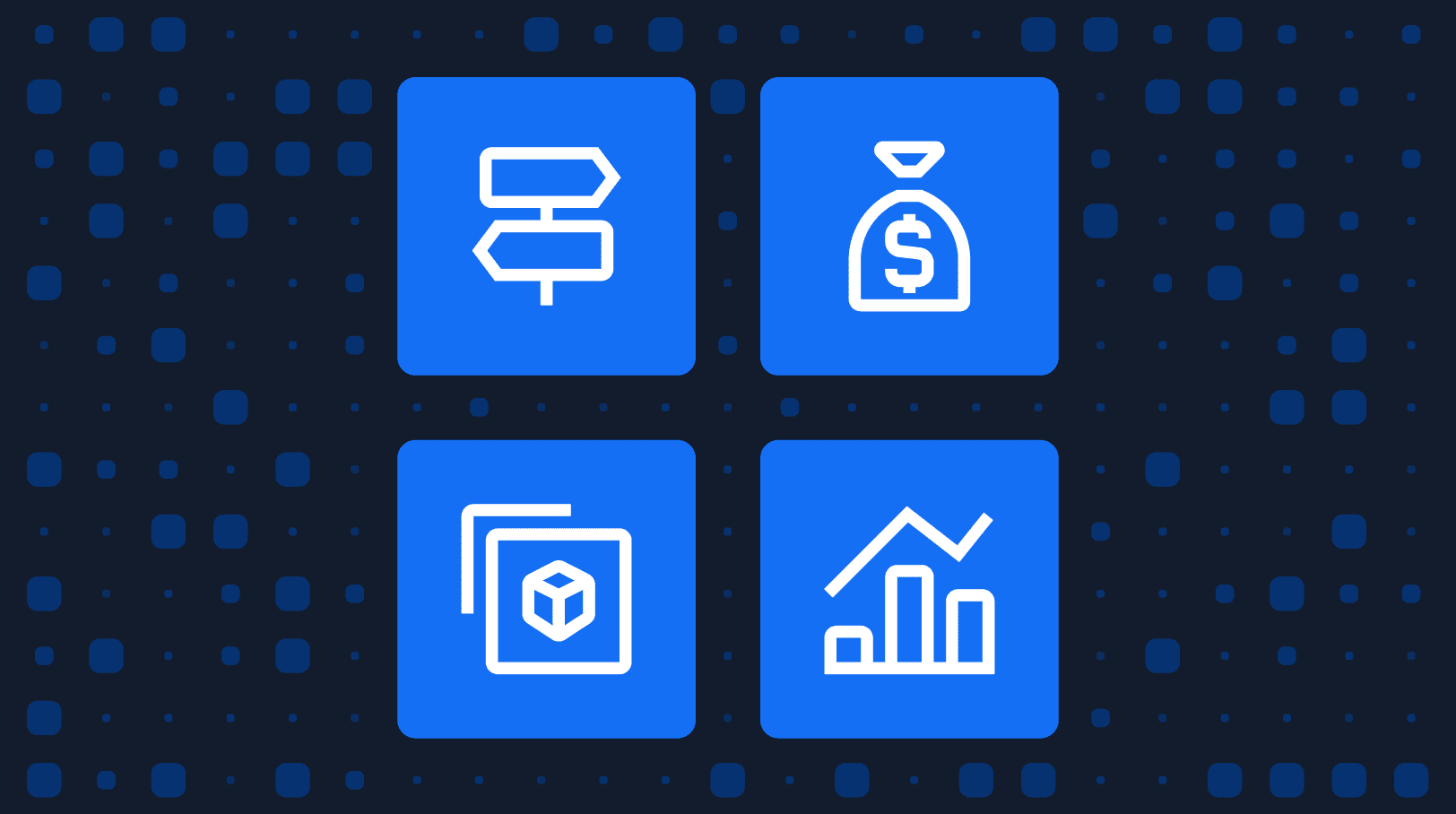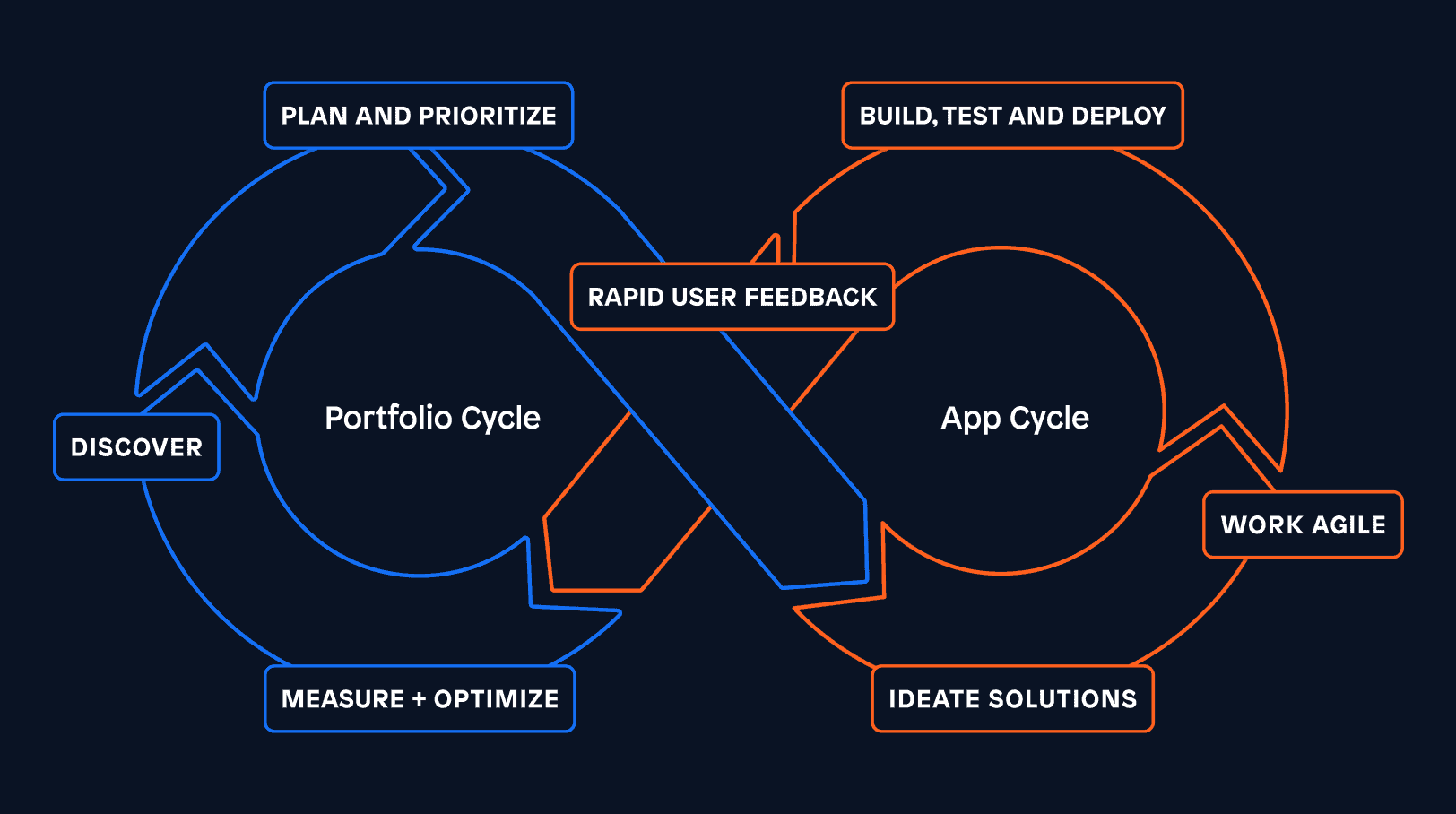Low-Code Application Portfolio Management
What is application portfolio management?
Application portfolio management is the practice of identifying, developing, measuring, and optimizing enterprise software applications.
Mendix’s Application Portfolio Management provides insights to help teams:
- Plan and prioritize projects
- Estimate app complexity
- Calculate business value
- Identify new opportunities
With Mendix, your business can easily improve efficiency, gain a competitive edge, and execute digital transformation.

Business benefits of application portfolio management
The importance of building an application portfolio management strategy
What happens if an investment portfolio is not actively managed? Depending on the size of the portfolio, an individual may risk running into huge financial losses. Similarly, if companies don’t have an active application portfolio management strategy in place, it may risk running into several expensive, and sometimes irreversible issues like technical debt, cost overrun, compliance and governance challenges, resource wastage, and more. In fact, with 68% of IT projects failing, it is important to build and manage an application portfolio that actively contributes to business goals rather than being a dead investment.
Furthermore, with Gartner projecting the demand for apps to grow 5x times than IT’s ability to deliver, having the right application portfolio management strategy can help companies successfully build new apps and manage the existing ones.

Matt Rogers
CIO of Suez UK
How to start with low-code application portfolio management
General Fit Decision
This step is to decide which business initiatives fit the low-code technology swim lane, and then build a broad portfolio of applications that from a business perspective has a low time to market and, from technical perspective has apps that are data-driven, user-friendly, and multidevice.
Largely apps fall in these three use cases – first, the innovation apps based on new technology like AI, IoT, blockchain, etc., second, the apps of differentiation like self-service portals or specific mobile services that are focused on customer engagement or operational efficiency, and third, the systems of record apps like billing systems, CRM and payroll.
Companies can map the above three use cases on two parameters: pre-defined requirements for building an app and rate of change – the likelihood of how fast and often the requirements of an app will change. Based on the nature of the use cases, innovation apps will have the least pre-defined requirement but the highest rate of change, while the systems of record app will have the most detailed pre-defined requirement but the least rate of change.
Since Mendix low-code platform follows an agile methodology, apps with a lower level of predefined requirements and a high expected rate of change – innovation apps and apps of differentiation – will be a perfect match for building the application portfolio.
Additionally, for successful apps of innovation or differentiation, it’s likely the app will need to source data from the existing systems of record. With Mendix technology this is really simple, and it will accelerate the app development drastically.
Define top candidates to start with
The purpose of this step is to identify the top five-to-ten apps from the broader application portfolio built in step 1 and to ensure the delivery of these applications will fulfill the value promised to the organization. The process of selecting your top candidates consists of asking (per app) five simple validation questions.
- Will the app deliver a wow response from its end-users?
- Does the app have clear business value?
- Can the first release be a minimal viable product (MVP) with enough features to satisfy the end-users?
- Does the app have high exposure among its end-users and low/medium complexity to build?
- Is the app a t-shirt size Small or Medium in terms of a few predefined categories like teams involved, integration requirement, MVP functionality expected, etc.?
If the answer is “yes” for all of them, that app is a top candidate. Ask the five questions until the portfolio is narrowed down to the top candidates.
Prioritize
The final step is to further narrow down the choices from the application portfolio built in step 2 and choose the best possible app to begin the app development journey. This step also arranges the remaining applications in the portfolio (from step 2) in the right order, creating a portfolio roadmap for the future.
Map the top candidates against the same five validation questions from step 2, but this time weigh and mark each app with a value for all the five questions. The mapping below shows the absolute winner considering “wow” factor, business value, complexity, and exposure level, as well as defines the roadmap for the remaining apps.
Releated resources
-
![]() How to Develop a Value-Centered Low-Code PortfolioWhat kind of value can you achieve with your low-code application portfolio? Learn why a value-centric approach to software delivery is key to success.
How to Develop a Value-Centered Low-Code PortfolioWhat kind of value can you achieve with your low-code application portfolio? Learn why a value-centric approach to software delivery is key to success. -
![]() The Goals of an Application Portfolio ManagerFrom rationalizing application landscapes to ensuring strategic alignment, the application portfolio manager is a vital role in modern enterprises. Read why.
The Goals of an Application Portfolio ManagerFrom rationalizing application landscapes to ensuring strategic alignment, the application portfolio manager is a vital role in modern enterprises. Read why. -
![]() How to Change Your Thinking About Application Portfolio ManagementA fellow CIO explains where traditional application portfolio management falls short, and provides a new way to think about managing your app portfolio for success.
How to Change Your Thinking About Application Portfolio ManagementA fellow CIO explains where traditional application portfolio management falls short, and provides a new way to think about managing your app portfolio for success. -
![]() Why Portfolio Management is Crucial to App Development at ScaleThe better you manage your portfolio, the smoother your software development lifecycle is. The benefit of a tighter, more aligned portfolio management practice is value. Here's how you unlock that for your own organization.
Why Portfolio Management is Crucial to App Development at ScaleThe better you manage your portfolio, the smoother your software development lifecycle is. The benefit of a tighter, more aligned portfolio management practice is value. Here's how you unlock that for your own organization. -
![]() How to Unlock Growth through Portfolio ManagementWatch this on-demand webinar where Mendix application portfolio management experts and Kevin Ferreira, IT Global Product Owner of Mendix at Jabil, outline what a good application portfolio management practice looks like.
How to Unlock Growth through Portfolio ManagementWatch this on-demand webinar where Mendix application portfolio management experts and Kevin Ferreira, IT Global Product Owner of Mendix at Jabil, outline what a good application portfolio management practice looks like. -
![]() Strategic Application Portfolio ManagementWatch Mike Tarentino, Senior Director of Digital Business Advisory at Mendix and Berend Sheffers, Product Manager at Mendix, show how to mend the disconnect between your strategic goals and your app portfolio.
Strategic Application Portfolio ManagementWatch Mike Tarentino, Senior Director of Digital Business Advisory at Mendix and Berend Sheffers, Product Manager at Mendix, show how to mend the disconnect between your strategic goals and your app portfolio.





